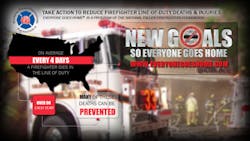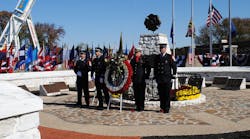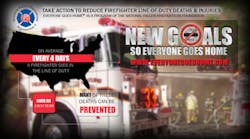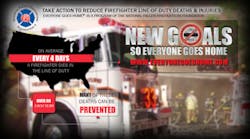By now, it’s become almost cliché to refer to the company officer as the most important position in the fire service. But that doesn’t make it less true. Company officers determine whether the crew will spend the shift working out and training or sitting on recliners. Company officers determine whether kitchen table discussions foster open-minded discussion about safe tactics, or promote a bravado-driven culture of excessive risk-taking. There simply is no other person in the fire service that has the daily impact on firefighters that company officers do. That’s why company officers are key to achieving the National Fallen Firefighters Foundation’s (NFFF) new goal of reducing firefighter line-of-duty deaths to under 50 annually.
For many company officers, becoming an officer is the consequence of the right mix of seniority and opportunity. There’s not always a lot of preparation aimed specifically at readying you to be the person in charge as opposed to just one of the crew. As a result, company officer development was an important part of the NFFF TAMPA2 summit last year and will continue to be a key focus of the NFFF’s efforts.
Whether your department has a robust company officer development program or a “sink or swim” approach, there are some things you as a company officer can do that can have a significant impact on the safety and survivability of those in your command. Here are five you can start with:
- Ensure that the rig doesn’t move until everyone’s belted in - We oftentimes think of firefighting as a dangerous profession because of fire, but the truth is, vehicle accidents that occur responding to and returning from calls continue to injure and kill a greater number of firefighters each year. In 2013, 11 firefighters died while responding to incidents. A seatbelt doesn’t always mean you’ll walk away unharmed, but it does greatly improve your chances.
- When your crew is operating at roadway incidents, require high-visibility vests - The Emergency Responder Safety Institute keeps a running tally of “struck by” incidents. At the end of February, it had already recorded five incidents in 2015 in which fire/EMS personnel were struck when responding to roadway incidents, some with multiple victims. For whatever reason, drivers often do not see firefighters operating on the roads. Unless you’re actively engaged in fire suppression-related activities (exposed to thermal insult heat), put on the vest and make sure others do too.
- Stock wet wipes in the apparatus - More and more research is detailing the dangerous chemicals we’re exposed to on the fireground, and the cancer risks that result. The good news is, decon doesn’t have to be a highly complex procedure. In a post-event survey, several TAMPA2 participants took the cancer message to heart and began carrying wet wipes on their apparatus for on-scene skin cleaning. Getting the chemicals off your skin as soon as possible reduces your exposure and, potentially, your risk of developing firefighting-related cancers.
- Reward safe practices - One of the key recommendations from TAMPA2 related to Life Safety Initiative #4 (empowerment) was to reward safe practices as a way of positively reinforcing and building a culture of safety. Company officers are in the best position to see safe behavior and immediately recognize it. Is your engineer especially fastidious about cleaning her PPE? Did your rookie firefighter take himself out of the fight at a house fire in extremely hot weather because he felt faint? Did a veteran member take the time to explain to some newer members about the dangers of the old auto parts warehouse down the street? Each of these is an opportunity for you to recognize the firefighter, reinforcing the importance of safe practices.
- Encourage health and fitness - Although you can’t control what your crewmembers do on their own time, you spend a lot of time with them in the station, where you can influence their health and wellbeing. Encourage everyone to eat together, and strive for meals that are heart-healthy (not all meals need to be weeds and nuts), include fresh fruits and vegetables whenever possible, incorporate low-fat protein and use only minimal amounts of processed foods and sugar. Devote part of every shift to some form of PT—whether it’s a functional fitness workout, a simple pick-up basketball game or training for an upcoming Memorial Stair Climb, Tough Mudder or other fitness event, do something every day. And push yourself to have those tough conversations when you notice a firefighter giving in to bad habits. An uncomfortable conversation now could prevent a heart attack later.
Becoming a better company officer isn’t just about learning to navigate personnel issues and moving from “buddy to boss.” It’s also about the little things you can do every day to set a standard for safe behavior and fulfill this incredibly important role.
It’s a powerful position, and a significant responsibility: To a large extent, the safety of your crew rests in your hands. Commit to doing your part, and together, we can reduce LODDs to under 50.
Editor’s note: Discuss company officer development issues with participants from TAMPA2 and other Firehouse.com readers in the Firehouse Forums:
- What is one characteristic you regard as essential to be a successful company officer?
- What training/development does your department provide before promoting firefighters to company officer?
- One idea that came out of the TAMPA2 summit was to carry baby wipes on the apparatus for immediate on-scene decon. What simple ideas have you/your department implemented that can have an immediate effect on firefighter safety and wellness?
TIMOTHY E. SENDELBACH is the Editor-in-Chief for Firehouse. A 29-year student and educator of the fire and emergency services, he is responsible for the content and editorial direction of Firehouse® Magazine, Firehouse.com, Firehouse Expo, Firehouse World and related products. He has served as an assistant fire chief with the North Las Vegas, NV, Fire Department, as the chief of training for Savannah, GA, Fire & Emergency Services and as assistant fire chief for Missouri City, TX, Fire & Rescue Services. He is a credentialed Chief Fire Officer and Chief Training Officer and has earned a master’s degree in leadership from Bellevue University, bachelor’s degrees in fire administration and arson and an associate’s degree in emergency medical care from Eastern Kentucky University. You can e-mail him at [email protected].









